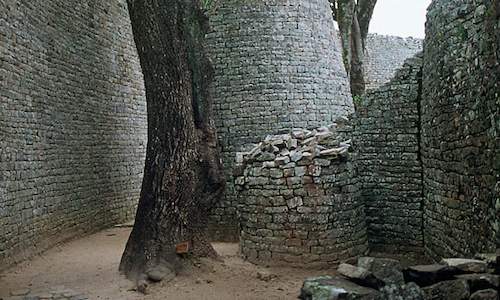History of Zimbabwe
An interesting historical timeline featuring the major events in the history of Zimbabwe.By Laurianne Claase
4 million years ago
Estimated dates of hominid communities established in southern and east Africa. These man-apes would have been no bigger than a ten-year-old child.
750 000 years ago
Homo erectus hunts the savannahs of southern Africa.
50 000 years ago
Homo sapiens takes the stage, ancestors of the San (Bushmen) and modern man.
8000 years ago
Earliest known examples of San cave paintings although none survive today. Present day Zimbabwe has the most concentrated collection of rock art in the world.
300 BC
Migration of Negro and Hamitic (Bantu) peoples south ahead of the spreading Sahara.
600 BC
Arab traders arrive in East Africa. Gradually, they spread further south establishing a major trading post at Sofala on the Mozambique coast.
300 AD
Earliest archaeological evidence of occupation at the site of Great Zimbabwe. The Gokomere people were spread throughout the Eastern Highlands, south into the Transvaal and as far as northeast Botswana.
Year 1000
Early Shona arrivals. The Karanga from the North install vassal states as they move south. Their impetus ceases south of the Limpopo where they subdue the local tribes and set up a relatively peaceful, monotheistic society which flourishes. The San are relegated to slave status.
Years 1100 -1400
The ruins of Great Zimbabwe, originally built as a shrine to the god Mwari, testify to a golden age of the Shona kingdom. Its rulers are god-kings with the absolute power of life and death.
Year 1450
A successful coup by Mwene Mutapa (Great Plunderer) ensures that his heirs inherit the title which is today remembered as Monomotapa. His son, Mutape, moves the capital to Fura Mountain near Mazowe. Trade with the Arabs in ivory, rhino horn and gold gives rise to an empire which controls the whole area from the Limpopo to the Zambezi.
Year 1490
Another coup, this time by Changa, a slave son of Mutape's who overthrows his legitimate successor with the help of Arab traders.
Year 1494
The son of the rightful heir regains control but the kingdom is split between the Mwene Mutapa at Fura and the Changamire at Zimbabwe.
Year 1514
Seventeen years after Vasco Da Gama successfully rounded the Cape of Good Hope and weighed anchor on the east African coast, Antonio Fernandez is the first European to document the lie of the land in the interior. He declares it fit for European habitation.
Year 1565
The King of Portugal sets his sights on all territory south of the Zambezi. Throughout the remainder of this century, the Portuguese manage to get a foothold in Zimbabwe, through a succession of diplomatic embassies, trade treaties, military aid and missionary forays to the Mutapa kings.
Year 1693
Rampant corruption eventually destroys the Portuguese stranglehold. The Changamire kingdom helps the Mutapa to expel the Europeans and they are gone for good by the turn of the century.
Year 1780
Events south of the Limpopo see Dingiswayo, chief of the Mtetwa clan, unite the loosely-knit South African tribes, by force.
Year - 1800
Dingiswayo falls at the hand of a young captain from the obscure Zulu clan. Shaka christens the entire tribe Zulu and hones the young men into a formidable fighting force which cut bloody swathes through southern Africa.
Year 1838
Mzilikazi, the son of a rebel captain executed by Shaka, flees north with his followers, crossing the Limpopo river and settling around present day Bulawayo. The Ndebele (or Matabele) bring with them the rule of war and within a generation, the name of Mzilikazi's son Lobengula fuels legends of fabulous wealth.
Year 1855
The English missionary, David Livingstone, names Victoria Falls after his queen on his epic cross-country journey along the river highway of the Zambezi. It has taken him from Luanda on the west coast of present day Angola to Quelimane on the Mozambiquan east coast. His subsequent reports to the London Missionary Society fuel a new wave of missionary zeal.
Year 1873
Great Zimbabwe 'discovered' by a European ivory-trader and geologist. Speculation runs rampant that this is the legendary Ophir, site of the fabled mines of King Solomon. The rush is on.
Year 1889
The English imperialist Rhodes, soon to be Prime Minister of the Cape, obtains a trumped up mining concession from Lobengulu who is caught between the expansionist Boers in South Africa and the British Empire represented by Rhodes and his dreams of a railway running from Cape to Cairo. He signs on an English dotted line and fails to read the fine print.
Year 1890
A Pioneer Column of over 100 wagons arrives from the South to exercise their mineral rights.
Year 1894
Rhodes' British South Africa Company has effective control of the territory and his name is given to the new country - Rhodesia.
Year 1896
The Matabele and Shona tribes unite in rebellion. The first Chimurenga (war of liberation) is extinguished by the end of the year and the settlers entrench themselves.
Year 1923
Company rule comes to an end. Rhodesia becomes a self-governing British colony.
Year 1953
Southern Rhodesia (Zimbabwe), Northern Rhodesia (Zambia) and Nyasaland (Malawi) are joined in a commonwealth federation of southern African British territories.
Year 1964
Rising black nationalism across the continent sees the break up of federation and independence for Malawi and Zambia. Only white Rhodesia remains under British rule. And it has seen the writing on the wall.
Year 1965
UDI. Unilateral Declaration of Independence by Ian Smith, leader of the minority Rhodesian Front and Rhodesia's Prime Minister.
Year 1966
The coalescence of the second Chimurenga led by the Matabele, Joshua Nkomo and the Shona, Robert Mugabe.
Year 1980
A protracted civil war finally secures independence. Robert Mugabe becomes Prime Minister. Canaan Banana becomes President.
Years 1981-1985
Matabeleland purge by Mugabe's North Korean-trained Fifth Brigade.
Year 1996
Government health service on brink of collapse. Zimbabwe is an effective one party state. Mugabe is returned to power on a thirty percent voter turnout.
Year 1998
Widespread riots amid involvement in the war in Congo, a depreciating currency and rampant inflation. Conditions remain unsettled.
Copyright © Laurianne Claase. All rights reserved. Reproduction in whole or in part without the permission of the author is prohibited.

No visit to Zimbabwe is complete without a visit to the Great Zimbabwe Ruins. During a tour of the ruins visitors can explore the incredible...
more
Zimbabwe safari guide - Thinking about going to Zimbabwe on holiday or safari ? Here are some reasons why you should visit Zimbabwe....
more
